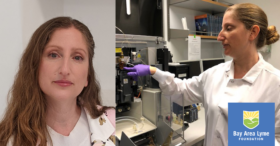FOR IMMEDIATE RELEASE
New Study Demonstrates Protein May Provide Protection Against Lyme Disease
Sweat protein protects against Lyme disease in vivo and is a potential therapeutic avenue for drug development
PORTOLA VALLEY, Calif. April 3, 2024—Bay Area Lyme Foundation, a leading sponsor of Lyme disease research in the US, recently announced the identification of an unknown common missense variant at the gene encoding for Secretoglobin family 1D member 2 (SCGB1D2) protein that increases the susceptibility for Lyme disease as well as two previously known variants. Published in the peer-reviewed journal Nature Communications, this study shows normal versions of the SCGB1D2 protein prevent infection by Borrelia in vivo and appear to be a host defense factor present in the skin, sweat, and other secretions, opening an exciting potential therapeutic avenue for Lyme disease. This research was also featured on NBC10 News in Boston.
“We are excited that our international collaboration with Hanna Ollia’s group and our co-authors has turned up such an exciting and unexplored avenue in the body’s defenses against Lyme disease,” said Michal Tal, PhD, Principal Scientist in the Department of Biological Engineering at MIT, and a Bay Area Lyme Foundation 2018 Emerging Leader Award winner. “This discovery reveals a human protein with protective activity against the bacteria that cause Lyme disease, which we hope could lead to a future path for exploring new methods to prevent and treat Lyme disease.”
This research has shown that the genetic variant of the SCGB1D2 which creates a misshapen protein appears to be specific for Lyme disease and has not been previously reported as associated with any other disease, phenotype, or infection. The researchers also found that about one-third of the population carries a genetic variant of this protein that is associated with Lyme disease in genome-wide association studies (GWAS).
“Tal’s discovery could be a real game-changer for Lyme disease patients as it has pinpointed a previously unknown factor in disease transmission. Hopefully, this research can be used to harness the protein’s protective abilities to create skin creams that could help prevent the disease or treat infections that don’t respond to antibiotics,” said Linda Giampa, executive director of the Bay Area Lyme Foundation.
The researchers utilized data from 617,731 individuals, including 25,355 individuals with Lyme disease who have participated in the FinnGen project or Estonian Biobank to estimate the effect of genetic variation on Lyme disease. They performed GWAS on these samples to identify the SCGB1D2 variant and two previously known variants, Human leukocyte antigen and Toll-like receptor 1 as loci that affect susceptibility to Lyme disease.
“In an era where the pursuit of groundbreaking advancements in Lyme disease treatment is more crucial than ever, the Bay Area Lyme Foundation stands as a beacon of hope and efficacy. With a steadfast commitment to channeling 100% of all donations directly into research, BAL ensures the early identification and support of extraordinary scientific talent. This is a hugely impactful way for donors to maximize the effectiveness of their contributions towards conquering Lyme disease,” said Emily Fairbairn.
The study received funding from the Fairbairn Family, with collaborative support from the Bay Area Lyme Foundation.
About Lyme disease
The most common vector-borne infectious disease in the US, Lyme disease is a potentially disabling infection caused by bacteria transmitted through the bite of an infected tick to people and pets, and may also be passed from a pregnant mother to her unborn baby. If caught early, most cases of Lyme disease can be effectively treated, but it is commonly misdiagnosed due to a lack of awareness and inaccurate diagnostic tests. There are approximately 500,000 new cases of Lyme disease each year, according to statistics released in 2018 by the CDC. As a result of the difficulty in diagnosing and treating Lyme disease, up to two million Americans may be suffering from the impact of its debilitating long-term symptoms and complications, according to Bay Area Lyme Foundation estimates.
About Bay Area Lyme Foundation
Bay Area Lyme Foundation, a national organization committed to making Lyme disease easy to diagnose and simple to cure, is the leading public not-for-profit sponsor of innovative Lyme disease research in the US. A 501c3 organization based in Silicon Valley, Bay Area Lyme Foundation collaborates with world-class scientists and institutions to accelerate medical breakthroughs for Lyme disease. It is also dedicated to providing reliable, fact-based information so that prevention and the importance of early treatment are common knowledge. A pivotal donation from The LaureL STEM FUND covers overhead costs and allows for 100% of all donor contributions to the Bay Area Lyme Foundation to go directly to research and prevention programs. For more information about Lyme disease or to get involved, visit www.bayarealyme.org or call us at 650-530-2439.
# # #
Media contact:
Tara DiMilia
Phone: 908-369-7168
Tara.DiMilia@tmstrat.com
